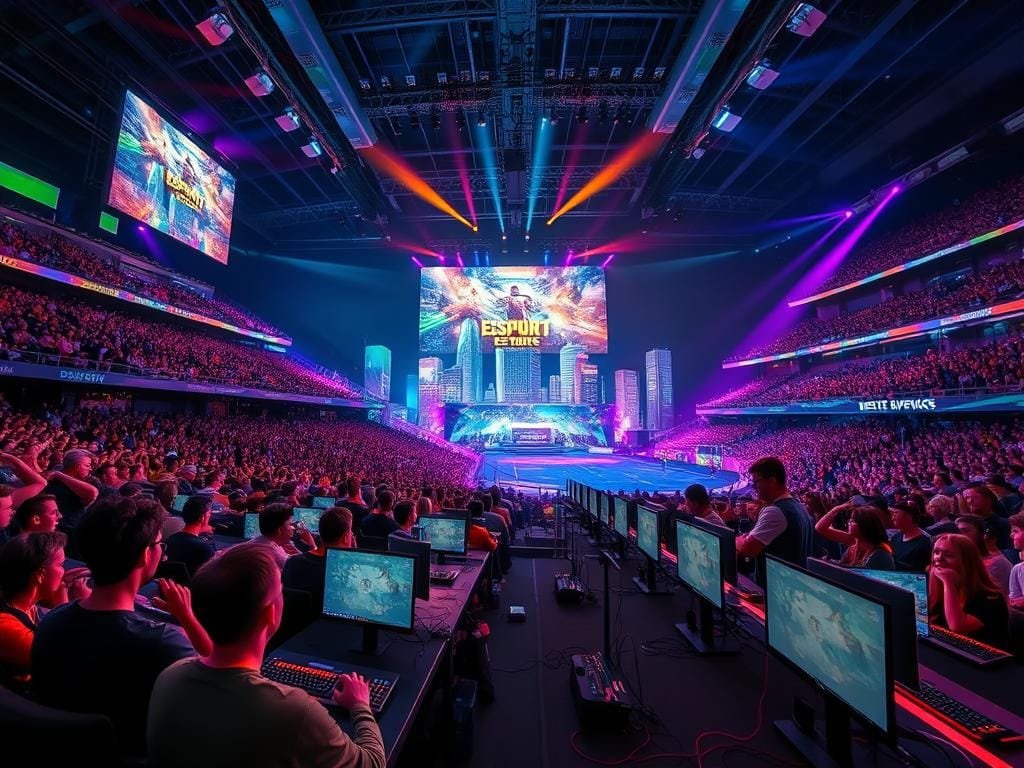The world of esports has grown huge, drawing fans from all over. It’s not just a passing fad. It’s now a big part of our pop culture, with big names like Coca-Cola and Intel investing heavily.
As esports keeps growing, new tech like 5G networks is making watching games better. It lets fans join in live and feel like they’re right there.
Key Takeaways
- The global esports audience has grown significantly, with viewership numbers in the hundreds of millions.
- Esports has attracted major brand investments, solidifying its place in mainstream culture.
- Technological advancements, such as 5G, are changing how we watch esports.
- Esports events are becoming entertainment spectacles with live engagement and interactive features.
- The future of esports includes innovations like AI-powered coaching and mixed reality broadcasts.
The Rise of Esports in Popular Culture
Esports started with early video games and has grown into a global event. It attracts millions of fans worldwide. The growth of esports is linked to video games and online gaming communities.
Historical Context of Esports
Esports’ history is tied to video games’ evolution. As technology improved, so did video games, making them more appealing. This led to the rise of competitive gaming.
Online gaming communities emerged in the early 2000s. They played a key role in shaping esports. Today, esports is a big part of online gaming culture. Many gamers now join tournaments and leagues.
Major Milestones in Gaming History
Esports has seen many key moments. The Cyberathlete Professional League (CPL) was founded in 1997, one of the first esports leagues. The release of StarCraft II in 2010 also marked a significant milestone, becoming a favorite in South Korea.
Streaming platforms like Twitch have also played a big role. They allow gamers to compete and fans to watch. The 2019 League of Legends World Championship final, for example, drew over 100 million viewers, showing esports’ massive appeal.
| Year | Event | Significance |
|---|---|---|
| 1972 | First video game tournament | Marked the beginning of competitive gaming |
| 1997 | Establishment of CPL | One of the first professional esports leagues |
| 2010 | Release of StarCraft II | Became a staple of competitive gaming |
The history of esports is rich and varied. Many events have shaped it into what it is today. Knowing this history helps us understand the esports world better.
Understanding the Esports Ecosystem
The esports world is made up of teams, sponsors, and a lively gaming community. It’s key to know the parts that make it grow and get more popular.
Key Players and Organizations
Esports teams and organizations are key. They give players chances to learn, train, and get support. Teams like Natus Vincere and FaZe Clan are well-known in gaming.
Teams have players, coaches, and staff. They help players get better and plan strategies. Here’s a look at a team’s structure:
| Role | Description |
|---|---|
| Players | Compete in tournaments and matches |
| Coaches | Develop strategies and train players |
| Analysts | Review gameplay and provide insights |
| Managers | Oversee team operations and logistics |
The Role of Sponsors and Advertisers
Sponsors and advertisers are vital. They give money to teams, players, and events. This helps the industry grow and stay strong. A Deloitte report says the esports industry will keep growing fast, thanks to more sponsor money.
“The esports industry has seen significant investment from sponsors and advertisers, which is critical for its continued growth.” –
Big names like Nike, Red Bull, and Intel have put a lot into esports. They see its value in reaching young, active fans. As esports grows, sponsors and advertisers will keep playing a big part.
Exploring esports means getting to know the ecosystem and its players. The mix of teams, sponsors, and the gaming community pushes the industry forward. It shapes its future and possibilities.
The Evolution of Gaming Technology
Gaming technology has evolved a lot, helping esports grow. You’ll see how new tech makes games better.
Advances in Hardware and Software
Gaming hardware has improved a lot. Now, we have high-definition displays and better audio. These changes make games more fun and help players get better.
New game engines have also helped. They let developers make games that feel real. For example, Unreal Engine and Unity make games look amazing. Learning about gaming evolution shows how tech has helped esports grow.

Impact of Streaming Platforms on Esports
Streaming platforms have changed how we watch esports. Sites like Twitch and YouTube Live let fans watch live games. You can find lots of gaming reviews and tips to get better.
Streaming also lets pros share their games and tips. This makes the community more interactive. As esports gets more popular, streaming will keep playing a big role.
In short, gaming tech has driven esports growth. As tech keeps improving, games will get even more exciting.
Key Esports Titles that Captured Audience Attention
Esports is growing fast, with some games leading the way. These games attract huge audiences and make pro gamers famous. You might know the buzz around big esports tournaments, where top players battle it out in games that are key to gaming today.
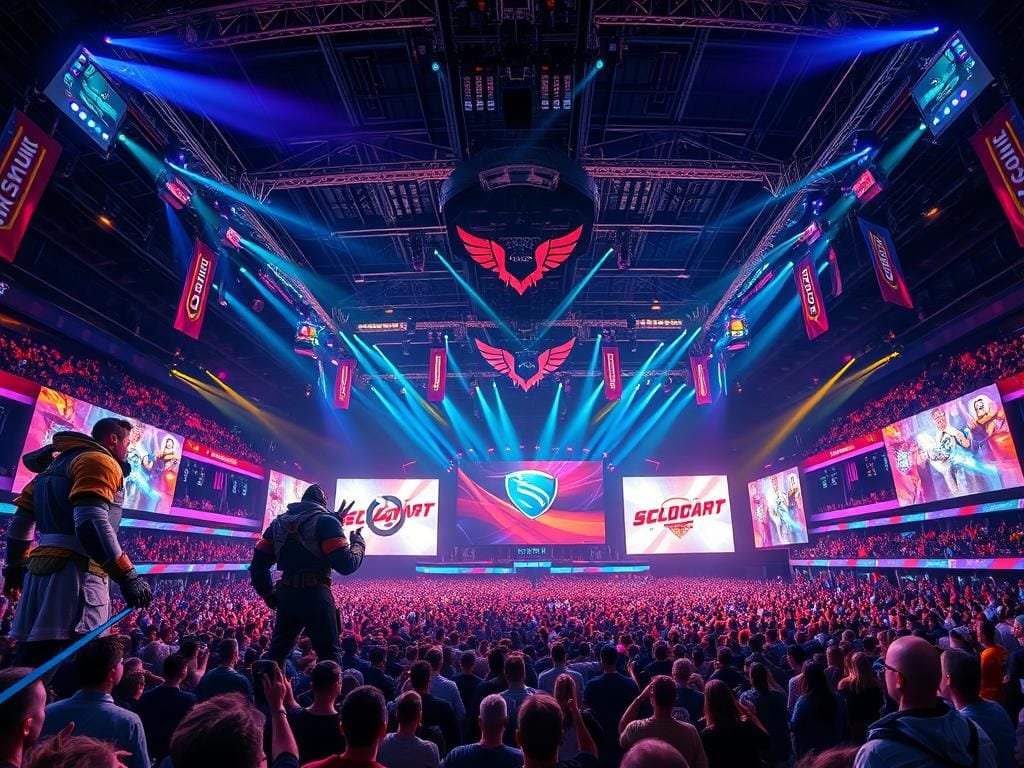
Popular Games Driving the Esports Boom
Games like League of Legends, Valorant, and Fortnite have huge player bases. They are key to major esports tournaments. For example, League of Legends has a detailed tournament system, with regional leagues leading to the World Championship, a top esports event.
Their success comes from fun gameplay, regular updates, and strong competitive scenes. Gaming tutorials and guides help new players get better. This grows the player base and builds a community.
Tournament Formats and Rules
Knowing the tournament formats and rules of popular esports titles is key. For instance, Valorant tournaments have a group stage and then a single-elimination bracket. Teams play best-of series matches. The rules, including game modes and scoring, are important for players and fans.
The way tournaments are organized, including scheduling, seeding, and prize pools, adds to the excitement. Big tournaments offer huge prizes, drawing in the best players from everywhere. This makes esports a big deal in entertainment.
The Role of Social Media in Esports Growth
Social media platforms are key in growing esports. They create lively communities. You’re part of a huge, active audience that follows esports teams, players, and events on different social media channels.
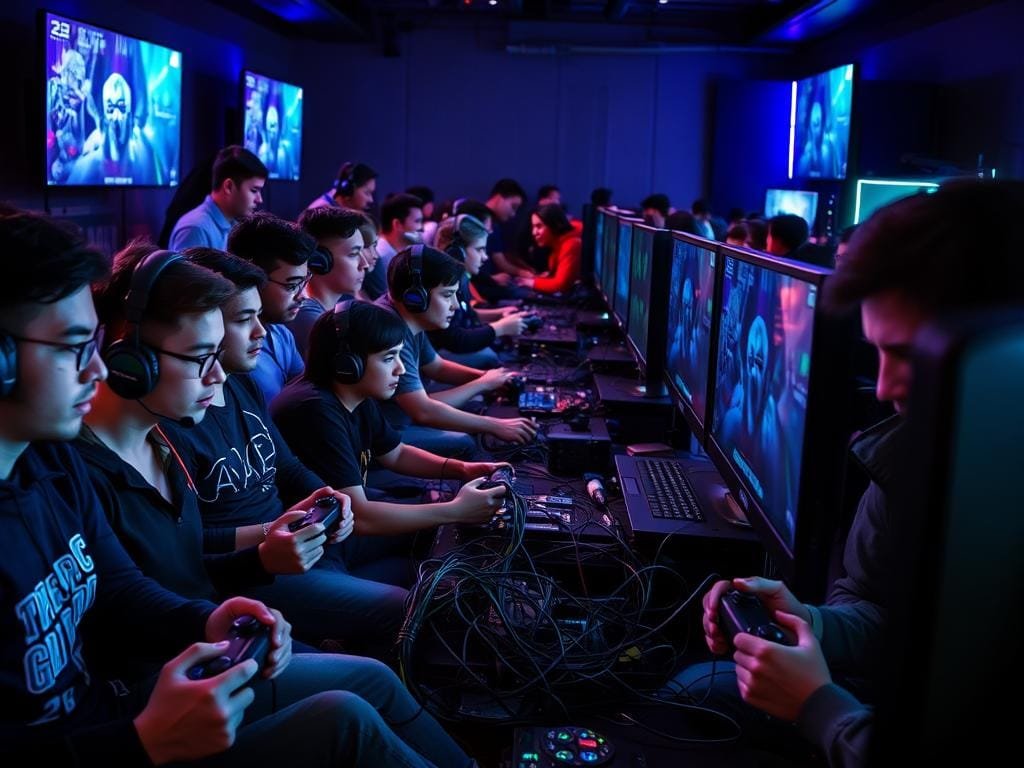
Building Communities and Fandom
Social media brings the esports community together. It lets us share experiences and support our favorite teams and players. Twitter, Instagram, and Facebook are where online gaming fans gather for discussions, live updates, and exclusive looks into esports.
As a fan, you can interact with esports content in many ways. You can join discussions on Reddit or watch live streams on Twitch. This interaction has strengthened the gaming community around esports.
| Platform | Primary Use | Impact on Esports |
|---|---|---|
| Real-time updates and discussions | Facilitates immediate engagement with esports news and events | |
| Visual content and community building | Enhances fan engagement through visual storytelling | |
| Twitch | Live streaming of esports events | Provides an immersive experience for fans, boosting viewership |
Influencers Shaping the Narrative
Influencers in esports have greatly influenced the narrative around it. They share their thoughts, opinions, and experiences. This shapes how the community views online gaming and esports.
For more insights on social media’s impact on gaming, check out The Game Marketer. They offer detailed analysis and trends in esports and gaming.
As esports keeps evolving, social media and influencers will keep playing big roles. You, as part of the gaming community, will keep driving the conversation and engagement around esports.
Major Tournaments and Their Influence
The world of esports has seen a big jump in major tournaments. This has changed the face of competitive gaming. These events have attracted huge crowds and helped make video games more popular worldwide.
Overview of Notable Esports Events
Events like The International for Dota 2 and the League of Legends World Championship are well-known. They stand out for their big prizes and intense competition. For example, many esports leagues and tournaments have shaped the industry.
Some key features of these events include:
- Large prize pools that attract top talent
- Global participation, with teams from various countries
- High production value, with professional commentary and analysis
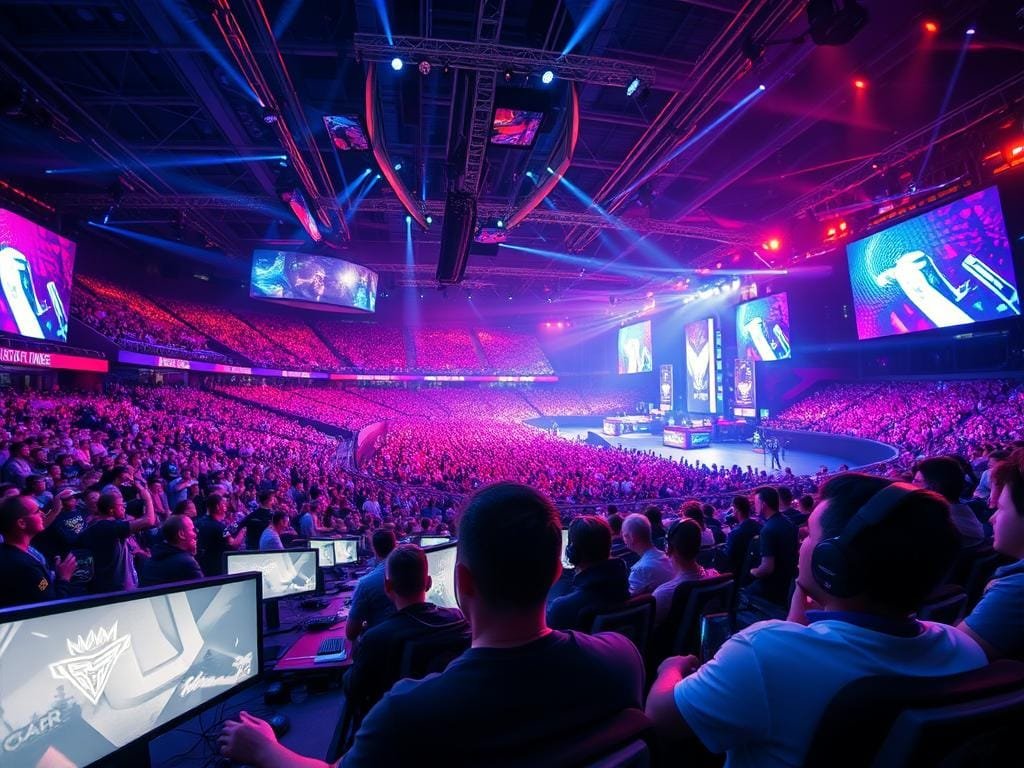
The Global Reach of Competitive Gaming
Esports tournaments have reached people all over the world. They are broadcast in many languages and are seen by people everywhere. The gaming news sector has also grown, with many outlets covering esports.
The global appeal comes from:
- The widespread popularity of video games
- Advancements in streaming technology
- Increased interest in competitive gaming
Esports has become a big part of entertainment today. Major tournaments are key to its growth.
Media Coverage and Broadcasting of Esports
Esports broadcasting has changed a lot. It now uses both old media and new online streams. This change has made esports media more diverse, reaching many different people.
Traditional Media vs. Online Streaming
The debate on whether to use old media or online streams for esports is ongoing. Old media, like TV, has been key for big esports events. It gives a familiar feel. But, online streams like Twitch and YouTube Live have changed how we watch esports. They offer live interaction and a more personal experience.
Younger people love online streams because they are flexible and offer community interaction. A recent survey found that over 70% of esports fans watch on online streams.
| Platform | Viewership | Engagement |
|---|---|---|
| Traditional TV | 30% | Limited |
| Online Streaming | 70% | High |
How Networks Approach Esports Broadcasting
Networks are changing how they broadcast esports. They invest in top-notch streaming, hire skilled commentators, and make fun content around events.
“The key to successful esports broadcasting is understanding the audience and providing an immersive experience.” – Esports Analyst
Some networks team up with esports groups to make special content. This makes watching esports even better. As esports grows, networks must keep improving to meet the demand for great broadcasts.
- Investing in streaming infrastructure
- Hiring experienced commentators
- Creating engaging content
- Partnering with esports organizations
By using these strategies, networks can offer a great esports viewing experience. This will attract and keep viewers interested.
The Economic Impact of Esports
Esports has a big economic impact, with many factors boosting its growth and creating jobs. As it grows, knowing its economic role is key.
Revenue Streams and Financial Growth
Esports has many ways to make money. These include:
- Sponsorship deals with big brands
- Advertising from online streams
- Selling merchandise
- Ticket sales for live events
Top esports teams get big sponsorship deals, like traditional sports teams. Brands like them because esports has a dedicated audience. This audience is young and tech-savvy. You can use gaming tips and tutorials to connect with this community.
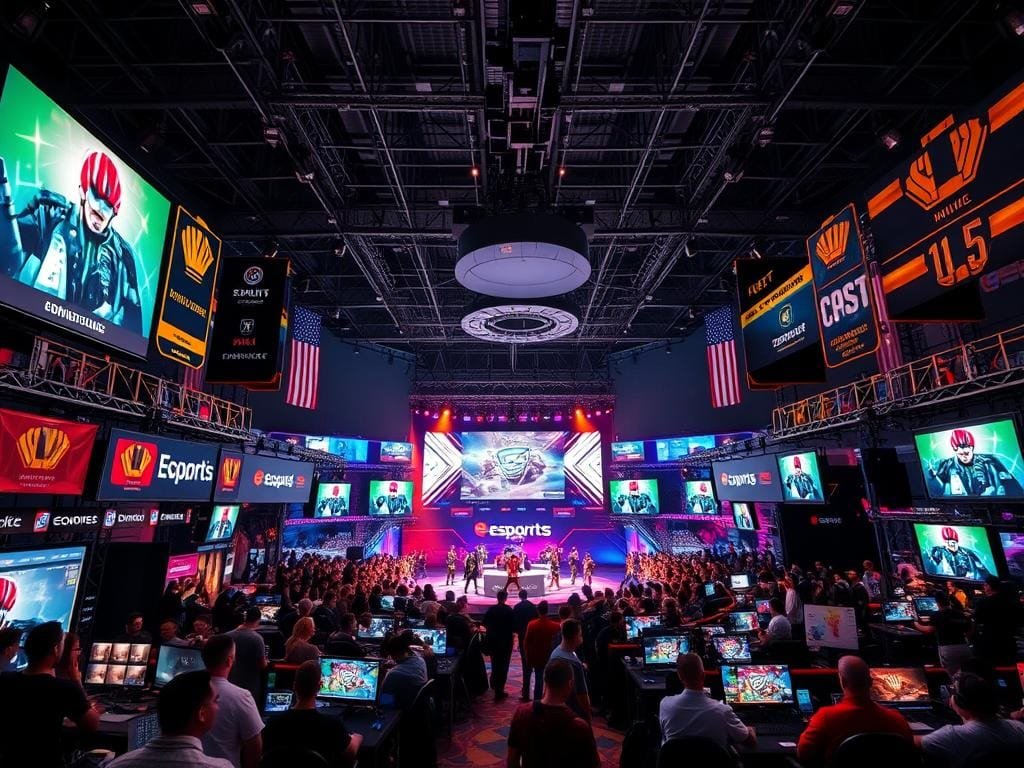
Job Creation within the Industry
Esports has created many jobs, both directly and indirectly. These jobs include:
| Job Category | Examples | Growth Potencial |
|---|---|---|
| Professional Gaming | Pro players, team managers | High |
| Event Management | Event organizers, stage managers | Medium to High |
| Content Creation | Streamers, YouTubers, analysts | High |
| Marketing and Sponsorship | Marketing managers, sponsorship coordinators | Medium to High |
As esports grows, so does the need for skilled professionals. For example, content creators can make gaming tutorials and tips. This can attract a big following and make money through ads and sponsorships.
There are many careers in esports, from playing games to managing events and creating content. The industry is growing fast, thanks to its popularity and the need for esports services.
Challenges Facing the Esports Industry
The esports industry is growing fast but faces many obstacles. These challenges must be solved for the industry to keep growing. As you dive into competitive gaming, you’ll see several big hurdles to overcome.
Regulation and Legality Issues
One big problem is the lack of clear rules and laws. Player contracts, prize money, and match-fixing need to be sorted out. Without standard rules, events can be confusing and unfair.
For more on these issues, check out this article.
Addressing Toxicity and Fair Play
Toxic behavior and ensuring fair play are big worries. Toxic behavior, like harassment and hate speech, can make games less fun and scare off new players. Keeping competitions fair is key to their integrity.
The industry is working hard to fix these problems. Esports groups are making rules and using tools to fight toxic behavior. They also want to teach positive values and sportsmanship.
As esports grows, solving these challenges is vital. By fixing rules and promoting a fair, positive gaming space, the future looks bright.
The Future of Esports and Gaming
The future of esports and gaming looks bright. New tech and changes in how we play will shape the industry. The number of esports fans worldwide is set to soar, reaching 577.2 million by 2024. Revenues are expected to hit $1,084 million in 2021.
Emerging Trends
New trends will bring us better streaming and virtual reality. These changes will change how we watch and play esports. For more on these trends, check out intenta.digital.
Industry Growth and Change
The esports and gaming world is set to grow and change. We’ll see more opportunities for gamers, sponsors, and advertisers. Events like the 2022 Commonwealth Games and the 2022 Asian Games show esports is becoming more popular.
FAQ
What factors have contributed to the rise of esports as a mainstream spectacle?
Esports has grown thanks to tech advancements and changes in how people watch games. It’s now seen as a real sport. Streaming platforms have also played a big role.
How has the esports ecosystem evolved over time?
The esports world has gotten more complex. It now includes teams, sponsors, and news outlets. These groups help shape the industry.
What role do popular esports titles play in driving the esports boom?
Top games have drawn in huge audiences. They’re key to big tournaments, driving the boom and shaping the scene.
How has social media influenced the growth of esports?
Social media has been key in growing esports. It helps fans connect and engage. Influencers also help tell the esports story.
What is the economic impact of esports, and how has it created job opportunities?
Esports has a big economic impact. It brings in money and creates jobs. This includes roles in reviews, tips, and tutorials.
What challenges does the esports industry face, and how are they being addressed?
Esports faces issues like regulation and concerns about fair play. The industry must work on these to grow and stay legitimate.
What trends are shaping the future of esports and gaming?
The future of esports looks bright. Tech advancements and new ways of watching games will shape it. The industry is expected to keep growing and innovating.
How has the broadcasting of esports evolved, and what role do traditional media and online streaming play?
Broadcasting esports is now a big part of its media coverage. Both traditional media and online streaming are involved. They’re finding new ways to reach the growing audience.
